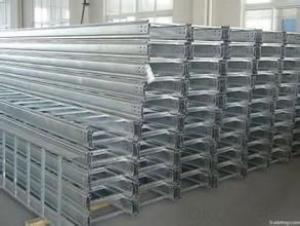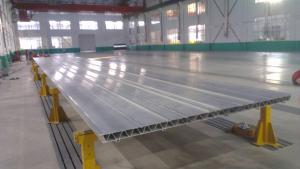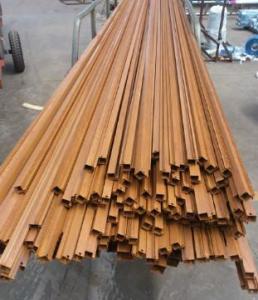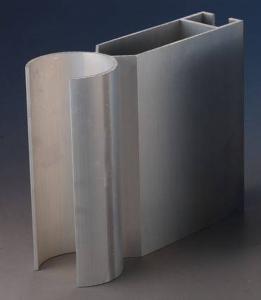Aluminum Extrusion Profiles Philippines for Any Use of Construction
- Loading Port:
- Shanghai
- Payment Terms:
- TT OR LC
- Min Order Qty:
- 1 m.t.
- Supply Capability:
- 1000 m.t./month
OKorder Service Pledge
OKorder Financial Service
You Might Also Like
Aluminium is a relatively soft, durable, lightweight, ductile and malleable metal with appearance ranging from silvery to dull gray, depending on the surface roughness. It is nonmagnetic and does not easily ignite. A fresh film of aluminium serves as a good reflector (approximately 92%) of visible light and an excellent reflector (as much as 98%) of medium and far infrared radiation. The yield strength of pure aluminium is 7–11 MPa, while aluminium alloys have yield strengths ranging from 200 MPa to 600 MPa. Aluminium has about one-third the density and stiffness of steel. It is easily machined, cast, drawn and extruded.
Aluminium alloys (or aluminum alloys; see spelling differences) are alloys in which aluminium (Al) is the predominant metal. The typical alloying elements are copper, magnesium, manganese, silicon, tin and zinc. There are two principal classifications, namely casting alloys and wrought alloys, both of which are further subdivided into the categories heat-treatable and non-heat-treatable.
Material | Alloy 6063,6061,6005or according to customer’s choice |
Temper | T3, T4, T5, T6 |
Surface | Anodize, electrophoresis, powder coating, PVDF coating, wood grain painting, matted, etc. |
Length | Coating 6.5 meters, Anodizing 6.5 meters, Mill finish 5-6 meters |
Application | Industrial, electrical equipment(TV set, air conditioner, refrigerator, computer), decoration,construction, transportation |
Custom Made | We can package following with customer's request. |
Products are exported to United States, Canada, U.A.E, Brazil, Mexico,Thailand, Vietnam, Nigeria etc, over 100 countries and regions all over the world.
FAQ:
1. What is the form of payment?
Normally 30% TT, L/C
2. Type of quotation?
FOB, CFR, CIF
3. Port of loading?
Shanghai port
4. Delivery time?
20 day after client’s deposit
- Q: This question asks about the various dimensions and forms of aluminum profiles that are typically utilized in the construction of building frames.
- <p>Aluminum profiles used in building frames come in a variety of sizes and shapes to meet different structural requirements. Common profiles include rectangular tubes, square tubes, angles (L-profiles), channels, and tees. Sizes range from small (e.g., 10x10mm to 30x30mm) to large (e.g., 100x100mm to 200x200mm), with thicknesses varying from 1mm to 6mm or more. Shapes are tailored to specific applications; for example, I-beams and H-beams are used for their high strength-to-weight ratio. These profiles are chosen based on load-bearing needs, aesthetic preferences, and construction techniques.</p>
- Q: How to prevent the aging of aluminum profile hardness is not enough?
- Raw materials, alloy, cast bar qualityDuring extrusion, the outlet temperature is guaranteed to be above the solid solution temperature,Cooling, quenching speed guaranteed as fast as possible
- Q: The user is inquiring about the efficiency of aluminum profile recycling in their region and seeks details on how it can be done.
- <p>Yes, aluminum profiles can be recycled efficiently in most regions due to their high value and the relatively low energy required for recycling. The process typically involves collection, sorting, melting, and recasting into new aluminum products. To recycle aluminum profiles in your region, you can check for local recycling centers or scrapyards that accept aluminum. Some municipalities also have curbside recycling programs that include aluminum. Ensure that the profiles are clean and free of non-aluminum components before recycling to maximize their value and efficiency in the recycling process.</p>
- Q: Can aluminum profiles be used in lighting fixture manufacturing?
- Yes, aluminum profiles can be used in lighting fixture manufacturing. Aluminum is a commonly used material in the lighting industry due to its various beneficial properties. It is lightweight, durable, and corrosion-resistant, making it ideal for outdoor and indoor lighting fixtures. Aluminum profiles can be easily shaped and manipulated to create various designs and forms, allowing for creative and innovative lighting solutions. Additionally, aluminum profiles can be coated or anodized to enhance their aesthetic appeal and provide additional protection against wear and tear. Overall, aluminum profiles are a popular choice in lighting fixture manufacturing due to their versatility, functionality, and aesthetic appeal.
- Q: This question asks for methods to ensure that the installation of aluminum profiles is both cost-effective and efficient.
- <p>To ensure the installation of aluminum profiles is cost-effective and efficient, follow these steps: 1) Plan carefully: Use accurate measurements and detailed plans to minimize waste and rework. 2) Use quality materials: Invest in high-quality aluminum profiles to reduce maintenance and replacement costs. 3) Employ skilled labor: Well-trained installers can complete the job faster and with fewer errors. 4) Optimize the installation process: Streamline the process to reduce time and labor costs. 5) Regular maintenance: Proper care and maintenance can extend the life of aluminum profiles, saving on replacement costs. 6) Compare suppliers: Shop around for the best prices and quality to minimize costs. 7) Use modular designs: Modular systems can be more efficient to install and easier to modify in the future.</p>
- Q: This question asks for the various types of adhesives that can be used for bonding aluminum profiles to building structures.
- <p>There are several types of adhesives used to attach aluminum profiles to building structures, including epoxy adhesives, which offer high strength and resistance to chemicals and temperature changes; polyurethane adhesives, known for their flexibility and durability; acrylic adhesives, which provide good adhesion on a variety of surfaces and are resistant to UV light; and silicone adhesives, which are excellent for sealing and bonding in environments with fluctuating temperatures. Each adhesive type has specific properties that make it suitable for different applications and environmental conditions in construction.</p>
- Q: This question asks for a method to determine the quantity of aluminum profiles required for a construction project.
- <p>To calculate the amount of aluminum profiles needed for a building project, follow these steps: 1. Determine the design specifications and dimensions of the project, including the length, width, and height of the structure. 2. Identify the types and sizes of aluminum profiles required based on the structural needs and design. 3. Calculate the total linear footage of each profile type needed by multiplying the length of each required section by the number of sections. 4. Add up the total linear footage for all profile types. 5. Account for waste and cutting losses, typically adding 5-10% to the total. 6. Ensure the calculations comply with building codes and safety standards. Consult with engineers or architects if necessary.</p>
- Q: Are aluminum profiles suitable for furniture applications?
- Indeed, furniture applications can benefit from the use of aluminum profiles. Aluminum, known for its versatility and lightweight nature, offers numerous advantages in furniture design and construction. To begin with, aluminum profiles boast exceptional strength and durability, making them the perfect fit for furniture that endures regular use and bears weight. Moreover, their resistance to corrosion allows for their usage both indoors and outdoors, without the worry of rusting or deterioration over time. Furthermore, aluminum profiles provide design flexibility. They can be effortlessly molded and shaped into various forms and sizes, allowing for the creation of innovative and unique furniture designs. Additionally, aluminum profiles can be extruded into diverse profiles and sections, enabling customization and adaptation to different furniture styles and requirements. Additionally, aluminum is an environmentally friendly material that can be recycled repeatedly without compromising its properties. This sustainable feature makes it an ideal choice for furniture applications. In conclusion, aluminum profiles offer a blend of strength, durability, versatility, and sustainability, making them highly suitable for a wide range of furniture applications.
- Q: Are aluminum profiles suitable for electrical conductivity applications?
- No, aluminum profiles are not suitable for electrical conductivity applications. While aluminum is a good conductor of electricity, aluminum profiles often have an oxide layer on their surface, which can hinder electrical conductivity. Additionally, aluminum profiles are prone to corrosion, which can further impact their conductivity. Therefore, materials with better conductivity properties such as copper or silver are usually preferred for electrical conductivity applications.
- Q: Can aluminum profiles be used in the production of electronics?
- Indeed, the utilization of aluminum profiles is viable when it comes to manufacturing electronics. Aluminum, being a metal that is both lightweight and resistant to corrosion, possesses exceptional thermal conductivity properties, rendering it suitable for a multitude of electronic applications. It is frequently employed in the fabrication of electronic enclosures and heat sinks. The malleability of aluminum profiles facilitates their effortless transformation into various shapes and sizes, thus enabling customization and flexibility in the creation of electronic components. Moreover, due to their electrical conductivity, aluminum profiles often serve the purpose of electromagnetic shielding. In summary, the incorporation of aluminum profiles in the production of electronics offers a plethora of benefits, including durability, efficient thermal management, and versatile design capabilities.
Send your message to us
Aluminum Extrusion Profiles Philippines for Any Use of Construction
- Loading Port:
- Shanghai
- Payment Terms:
- TT OR LC
- Min Order Qty:
- 1 m.t.
- Supply Capability:
- 1000 m.t./month
OKorder Service Pledge
OKorder Financial Service
Similar products
Hot products
Hot Searches
Related keywords


























